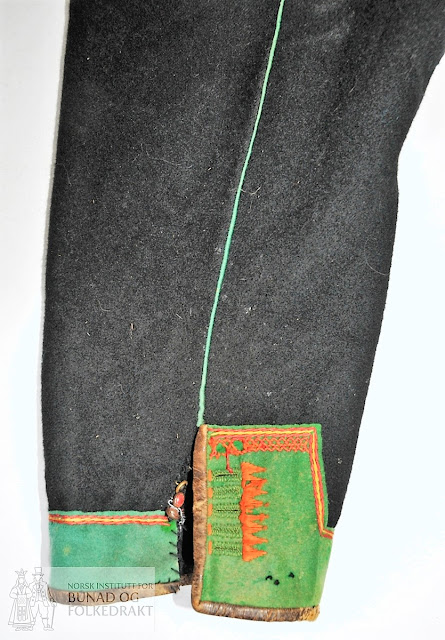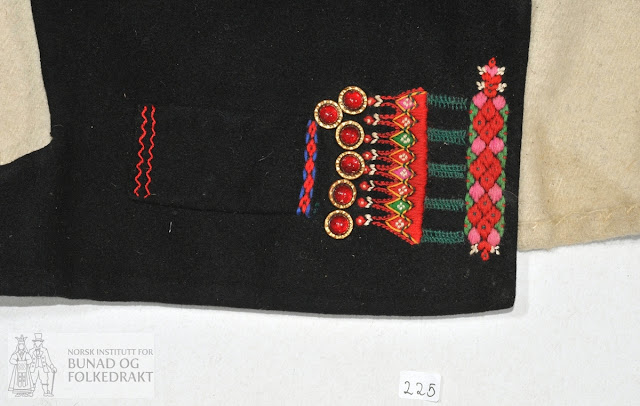Hello all,
Today I will continue my series on the costume and embroidery of Setesdal, East Agder, Norway. The Women's outfit has remained essentially the same for at least three hundred years, but the men's changed significantly about 150 yrs ago. The current outfit does not resemble any other men's attire anywhere in the region.
One theory of its origin is that sailors from Setesdal wanted to imitate clothing they saw abroad, perhaps in Spain, and so created this ensemble.
The base garment is the shirt, skjorte, which is identical in cut to the women's shirt.
It was likely originally linen, but today is usually made of cotton. For festive dress the collar and cuffs are edged with lace or tatting.
The main garment of the outfit is called bukse, dalebukse or skinnfo. It resembles a set of bib overalls more than anything else. It is made of black wadmal, a type of heavy homewoven wool.
The bib and cuffs have patches of embroidered green wool sewn onto them. Some also have green wool strips below the pocket openings. Others either do not have pockets, or the pockets are internal. There is a large leather patch on the seat, and also two patches on the upper inseam of the legs. These last have a narrow projection which extends from the crotch up to the middle of the bib. When new, the leather is black.
There are two leather straps which button to the bykse front and back. The front buttons are attached to buckles which make the straps adjustable.
A seam leads from the side of the bib straight down to the cuffs, where there is an opening for the foot. This seam is always picked out with green piping.
The bukse, even if they are modeled on Matador outfits, are made to fit loosely. This is for ease of movement, comfort, warmth, and also because typically nowadays, a man receives a bunad for his confirmation, and then wears it for the rest of his life, so he needs some room to grow.
Here are a couple of young men on whom the bukse are rather large, notice that the back comes almost to the shoulder.
This man has obviously grown quite a bit since he got his bunad, but by lengthening the straps, he can still wear it. Today it is unusual for a boy as young as his son to have the bunad, but it can be handed down.
The embroidery on the bib, like that on the women's outfit, has standard placement, but the exact design varies. Even the extent of the embroidery varies somewhat.
Note that both the bib and the cuffs are edged with black leather. This is a heavy garment, so the buttonholes are reinforced. Pockets are made of linen.
The vest often has buttons and a gold plated silver clasp, and sometimes has small pockets in front. The armholes may be edged in green or black.
In cold weather the famous Setesdal sweater is added. This is usually called 'lusekofte', which means 'louse sweater'. This is a reference to the traditional design of white dots on a black background, which looks like lice crawling on the body. It was originally made of natural dark and pale wool, but nowadays is usually made of wool dyed black and bleached white. The body and sleeves are knitted, but the collar, cuffs, and front plackets are of embroidered woven wool. Because it was worn inside the bukse, in older examples the bottom was left plain white, because it would not be seen. Some examples also feature a white woven wool lining on the yoke. Unlike some other parts of Europe, like the Slavic countries, knitting is an old tradition in Scandinavia.
The vest is often worn over the lusekofte.
A gråkupte, or gray jacket, similar to that worn by women is sometimes worn, as we can see by the man on lhe right above. Normally leather shoes are worn, but he has put on boots as well. A couple more images of the gråkupte. See also the image at the head of the article.
These men are comparing Sølje. Silver is part of every Norwegian bunad. It includes the filligree buttons on the bukse, vest, lusekupte, as well as the clasps on the vest, pocket watches on chains, silver chains on the hat, as well as collar and cuff buttons on the shirts, and pins to hold the shirts closed. The man on the right has a knife in a sheath which buttons to his bukse. The square shirt pin seen here is also worn in Telemark.
These two men have fancy silver pocket watch chains.
On the day of his wedding, a man would put on the 'bridegroom's cross' on a silver chain, and then would wear it for special occasions after that. You can see that this man is dressed for his wedding. He also has a knife and sheath buttoned to his bukse.
Men may also wear embroidered gloves when it is cold. These are commonly given as gifts by those who make them.
There is one more type of jacket which is worn by men and boys in Setesdal. This is called grautkupte, which means 'porridge jacket', because it keeps you warm as porridge. It is made of black wool with green cuffs and front plackets which have some embroidery. It has a clasp at the neck, and hooks that enable it to be closed down the front.
There is a practice which is common to many places of putting small boys into frocks or kirtles. This was also done in Setesdal, where a boy's frock was called guttekjole. Many silly stories have been spun to explain this, often about tricking the elves, faeries or evil spirits. The truth is much more prosaic; little boys were not put into pants until they were out of diapers, it was just not practical until they were 'dry'.
Just a couple more images of this bunad.
Roman K.
email: rkozakand@aol.com
Here is a video which shows scenery, music and dance from Setesdal. The dancing starts at the 1:45 mark.
https://www.youtube.com/watch?v=-m4yHJjGvpw
Here are two websites where you can order this costume if you wish.
http://www.setesdalsbunad.no/omoss
http://www.setesdalhusflid.no/?menuid=7
Source Material:
Norske Digitaltmuseum
Aagot Noss, 'Stakkeklede i Setesdal', Oslo, 2008
Laila Duran, 'Bunader og Tradisjoner fra Setesdal', 2015
Bjorn Sverre hol Haugen, 'Norsk Bunadleksikon' Oslo, 2009
Kjersti Skavhaug et al, 'Norwegian Bunads', Oslo, 1991
Heidi Fossnes, 'Norges Bunader og Samiske Folkedrakter', Oslo, 1993
Ellen Scheel et al, 'Bunad-Brodering', Oslo, 1997
Janice Stewart, 'The Folk Arts of Norway', University of Wisconsin, 1953
Guvnor Traetteberg, 'Folk Costumes of Norway', Oslo, 1966, 1976
Thorbjorg Ugland, 'A Sampler of Norway's Folk Costumes', Oslo, 1996
Laila Duran, 'Scandinavian Folklore vol I - III', Sweden, 2011-2013



















































































































Lots of special trousers - Thanks so much !
ReplyDeleteThanks für your work, merry christmas.
Regards from Cologne - Silvia (handweaver)
Nice outfit collection. Thank you for the post. Always wear luxurious & authentic perfumes to look more confident & beautiful. Browse ScentGod, We have more than 400+ perfumes for both men & women. visit the website & view all your favorite brand perfume collections.
ReplyDeleteHair care isn't just about aesthetics; it's also about maintaining the health of your scalp. Regularly cleansing your scalp with a gentle shampoo and conditioner can help remove buildup and keep your hair follicles clear. Be mindful of any scalp issues such as dandruff or itching, as these may indicate underlying problems that require attention. And don't forget to protect your scalp from the sun by wearing a hat or using sunscreen when outdoors for extended periods. https://premiumbarbershop.com/
ReplyDeletegreat
ReplyDeleteThis is an excellent, well researched and well presented article. Thank you for your research and making it available on a publicly accessible forum.
ReplyDeleteI do have one suggestion and that regards the origin of the style of the man's bunad. I would not infer that it was styled after the matador's clinging outfit but rather was brought back on the return of the young men who left the Setesdal valley and found work on fishing boats or as mercenaries in the Navy (likely Spanish or Portuguese). The basic style of loose-fitting bib-overall was typical work wear on ships. Always being practical, the suitability of such a style of garment for work around the farms was recognized and this style of garment was adopted and worn as everyday work wear. There is sufficient photographic documentation (even in the photos provided above) to validate that this very style of garment was worn as daily work wear - before it was elevated to the level of a Bunad as it is today.
The reason for the leather reinforced backside had always puzzled me as no other man's bunad had such a reinforcement, until another historian pointed out the simple fact that the leather reinforcement made the garment more durable and last longer. As opposed to men's bunads from other regions, the Setesdal bukse was actually worn as working clothes around the farm. The wadmal fabric used to make the bukse was very expensive to make, so again being practical, leather was used to strengthen the garment and protect the areas most likely to receive the most wear.
Thank you again for your contribution - I myself wear this bunad and find its history fascinating.
Bu web sitesindeki bazı gerçekten kaliteli blog gönderileri, favorilere kaydedildi.
ReplyDelete